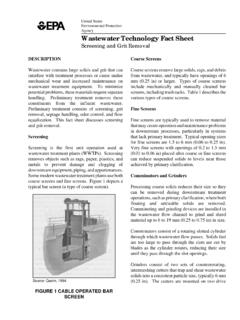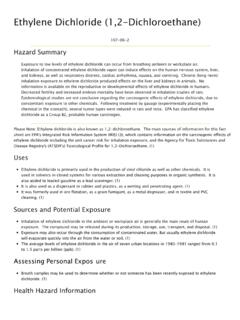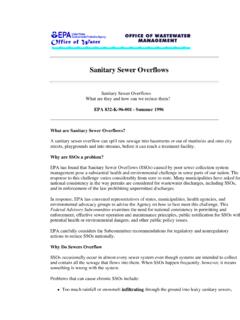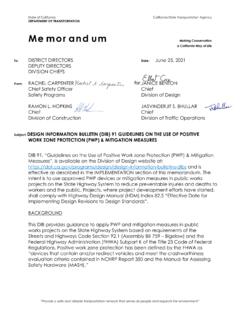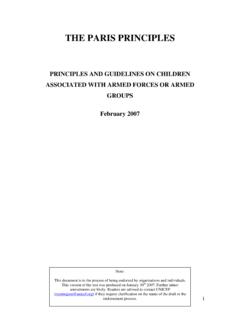Transcription of United States Environmental Protection Agency Office of ...
1 1 United States Environmental Protection Agency Office of Prevention, Pesticides and Toxic Substances (7505P) _____ Pesticide Fact Sheet Name of Chemical: Chlorantraniliprole Reason for Issuance: Unconditional Registration Date Issued: April 2008 _____ TABLE OF CONTENTS 1. Description of the 2. Use patterns and 3. Science 4. Human Health Exposure 5. Environmental Exposure and 6. Regulatory Position and 7. Reduced Risk 8.
2 Contact 9. Appendix I: Glossary of Terms and 10. Appendix II: 1. DESCRIPTION OF CHEMICAL Chemical Name: 3-Bromo-N-[4-chloro-2-methyl-6-(methylca rbamoyl)phenyl]-1-(3-chloro-2-pyridine-2 -yl)-1H-pyrazole-5-carboxamide Empirical Formula C18H14N5O2 BrCl2 Common Name: Chlorantraniliprole Experimental Name: DPX-E2Y45 EPA PC Code: 090100 2 Chemical Class.
3 Anthranilic diamide insecticide Mode of Action: Interruption of normal muscle contraction Pesticide Type: Insecticide Technical Registrant: DuPont Crop Protection Box 30 Newark, DE 19714-0030 Chemical Structure: NNNNHOClBrNHOCl 2.
4 USE PATTERNS AND FORMULATIONS Registered Uses: pome fruit (crop group 11), stone fruit (crop group 12), leafy vegetables (crop group 4), Brassica leafy vegetables (crop group 5), cucurbit vegetables (crop group 9), fruiting vegetables (crop group 8), cotton, grapes, potatoes, rice, and ornamentals and turf grass growing in residential, commercial, and public landscaped areas Pests/Application Sites: moths, beetles, caterpillars, etc.
5 Application Rates: Seasonal Maximum: Food Crops- lb (rice- ) Turf Grass- lb Ornamentals- highly variable, range between to lb Types of Formulations/ Product Names: Technical.
6 DuPont Rynaxypyr Technical ( ) End Use (Agricultural Uses): DuPont Coragen ( ; suspension concentrate) 3 DuPont Altacor (35% ; water dispersible granule) End Use (Turf and Ornamental Uses): DuPont E2Y45 SC Insecticide (.)
7 Suspension concentrate) DuPont E2Y45 Insecticide ( ; granular) DuPont E2Y45 Insecticide ( ; granular) DuPont E2Y45 Insecticide + Fertilizer (.
8 Granular) Manufacturing Concentrate (35% ) 3. SCIENCE FINDINGS Physical and Chemical Characteristics: Available product chemistry data supporting the use of chlorantraniliprole are summarized below in Tables 1 and Table 1. Chlorantraniliprole Nomenclature. Chemical structure NNNNHOClBrNHOCl Common name Chlorantraniliprole Company experimental name DPX-E2Y45 IUPAC name 3-Bromo-N-[4-chloro-2-methyl-6-(methylca rbamoyl)phenyl]-1-(3-chloro-2- pyridine-2-yl)-1H-pyrazole-5-carboxamide CAS name 3-Bromo-N-[4-chloro-2-methyl-6-[(methyla mino)carbonyl]phenyl]-1-(3-chloro-2-pyri dinyl)-1H-pyrazole-5-carboxamide CAS registry number 500008-45-7 Table Physiochemical Properties of the Technical Grade Test Compound Parameter Value Melting point/range ( C) 200-202 ( )/208 210 ( ) pH at 20 C Relative Density ( )
9 ( ) at 20 C 4 Table Physiochemical Properties of the Technical Grade Test Compound Parameter Value Water solubility (20 C) Deionized Water mg/L pH 4 mg/L pH 7 mg/L pH 9 mg/L Solvent solubility (20 C) Acetone g/L Acetonitrile g/L Ethyl Acetate g/L Dichloromethane g/L Dimethylformamide 124 4 g/L n-Octanol g/L Methanol g/L n-Hexane < g/L o-Xylene g/L Vapor pressure x 10-12 Pa @ 20 C, x 10-11 Pa @ 25 C Dissociation constant, pKa Octanol/water partition coefficient, KOW (20 C)
10 Deionized Water 589 pH 4 588 pH 7 721 pH 9 654 UV/visible absorption (max) pH <2 no absorption max >200 nm, at 290 = 3941 pH 7 no absorption max >200 nm, at 290 = 4185 pH >10 absorption max at ~320 nm which may be due to decomposition of DPX-E2Y45, at 290 = 6082 Metabolism Assessment: The nature of the residue in plants and livestock is adequately understood. Very little degradation was observed in primary and rotational crops. Unchanged parent chlorantraniliprole was the major identified residue in primary and rotational crops.










